The PET Dome Lids Market is estimated to be valued at USD 16.6 billion in 2025 and is projected to reach USD 33.2 billion by 2035, registering a compound annual growth rate (CAGR) of 7.2% over the forecast period.
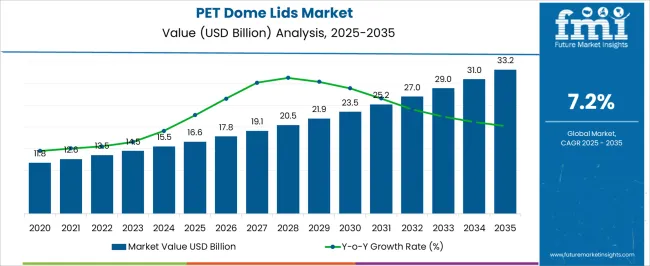
| Metric | Value |
|---|---|
| PET Dome Lids Market Estimated Value in (2025 E) | USD 16.6 billion |
| PET Dome Lids Market Forecast Value in (2035 F) | USD 33.2 billion |
| Forecast CAGR (2025 to 2035) | 7.2% |
The PET dome lids market is expanding steadily, driven by rising consumption of on-the-go food and beverage products and increasing demand for sustainable packaging solutions. Industry publications and packaging company press releases have highlighted strong growth in ready-to-drink beverages, bakery items, and takeaway meals, all of which rely heavily on PET dome lids for spill resistance and product visibility.
The material’s durability, lightweight nature, and recyclability have made it a preferred choice across multiple end-use industries. Additionally, regulatory focus on recyclable plastics and corporate sustainability initiatives are boosting PET adoption over alternative materials.
Design innovations in dome lids that enhance user convenience and product presentation are also accelerating their use in retail and foodservice environments. Future growth is expected to be supported by the expansion of quick-service restaurants, e-commerce-driven food delivery services, and consumer preference for hygienic, tamper-evident packaging solutions. Key momentum will continue to come from PET as a material, non-cavity designs for cost and performance efficiency, and strong demand from the ready-to-drink beverage sector.
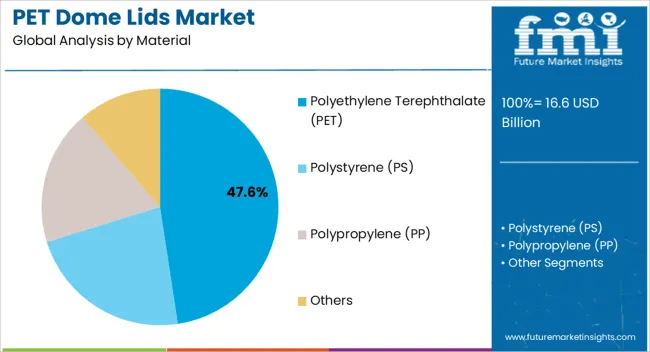
The Polyethylene Terephthalate (PET) segment is projected to account for 47.60% of the PET dome lids market revenue in 2025, maintaining its leadership due to its recyclability and performance benefits. Growth in this segment has been influenced by rising consumer and regulatory demand for sustainable packaging solutions, with PET recognized for its compatibility with established recycling streams.
PET dome lids have also been favored for their clarity, strength, and barrier properties, which enhance both product presentation and protection. Packaging companies have increasingly prioritized PET due to its cost-efficiency and ability to meet stringent food safety standards.
Furthermore, beverage and foodservice brands have aligned with PET usage to demonstrate environmental responsibility, supporting long-term adoption. As sustainability remains central to packaging strategies, PET is expected to retain its leading share in the material segment.
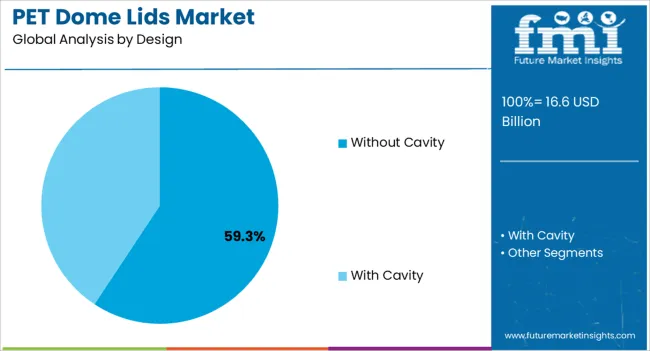
The Without Cavity segment is projected to contribute 59.30% of the PET dome lids market revenue in 2025, emerging as the dominant design preference. Growth has been driven by the functional simplicity and cost-effectiveness of non-cavity lids, which are widely used in beverages, ice creams, and desserts.
Industry observations have indicated that without-cavity dome lids provide enhanced stackability, reduced storage space, and better sealing performance, making them highly suitable for high-volume foodservice operations.
The absence of cavities also reduces material usage per unit, aligning with efficiency-focused manufacturing strategies. With the increasing demand for takeaway and quick-service products, businesses have adopted without-cavity lids as a practical solution that balances utility, cost, and sustainability considerations. This trend is expected to reinforce the segment’s dominant position in the market.
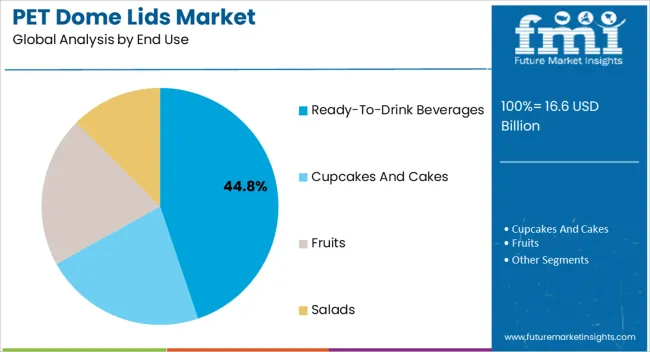
The Ready-To-Drink Beverages segment is projected to hold 44.80% of the PET dome lids market revenue in 2025, securing its place as the leading end-use category. Growth in this segment has been supported by the rising consumption of smoothies, iced coffees, milkshakes, and other cold beverages that require protective yet transparent dome lids.
Beverage brands have preferred PET dome lids for their ability to enhance product visibility, appeal to consumers, and ensure spill resistance during transportation. Reports from the beverage packaging industry have emphasized the role of dome lids in supporting the growing ready-to-drink trend, particularly in urban markets with strong demand for convenience and on-the-go consumption.
Additionally, the global expansion of café chains, juice bars, and specialty beverage outlets has fueled demand for PET dome lids in this segment. With changing consumer lifestyles and rising preference for premium beverages, the Ready-To-Drink Beverages segment is expected to remain the largest contributor to market revenue.
The global demand for PET dome lids increased at a CAGR of 3.5% during the forecast period between 2020 and 2025, reaching a total of USD 33.2 billion in 2035. According to Future Market Insights, a market research and competitive intelligence provider the PET dome lids market was valued at USD 16.6 billion in 2025.
Visual appeal and branding are integral components of marketing and customer engagement, and in the context of the food industry, they play a crucial role in influencing consumer perceptions and driving purchasing decisions. The transparent and aesthetically pleasing design of PET dome lids contributes significantly to enhancing the visual appeal of packaged products, thereby creating a positive impact on the overall branding strategy of businesses.
PET dome lids offer a clear view of the contents within the packaging, allowing customers to visually assess the quality, freshness, and presentation of the food items. For restaurants and food businesses, this provides an opportunity to showcase their commitment to using premium ingredients and delivering well-prepared dishes. When customers can see the vibrant colors, textures, and layers of a meal, it builds trust and confidence in the brand's offerings.
The saying "we eat with our eyes first" holds true in the world of food. PET dome lids create a literal window into the delectable creations inside, tantalizing the senses and arousing appetite. The ability to visually connect with the food can trigger cravings and anticipation, making the dining experience more enjoyable even when customers are eating at home.
Growing QSR and Fast-Casual Drinking is Likely to be Beneficial for Market Growth
The rise of quick-service restaurants (QSR) and fast-casual dining is reshaping the way people eat, emphasizing speed, convenience, and quality. PET dome lids play a pivotal role in meeting the evolving demands of modern consumers who are looking for efficient and portable food options. The use of PET dome lids aligns seamlessly with the operational and customer experience goals of QSR and fast-casual establishments.
Modern lifestyles are increasingly fast-paced, and consumers often find themselves eating on the go. QSR and fast-casual dining cater to this need by providing quick and convenient meal options. PET dome lids provide an ideal solution for packaging these meals, allowing customers to carry their food easily and securely without worrying about spills or leakage.
PET dome lids are designed for easy handling and sealing, making them a convenient choice for customers who want to enjoy their meals without the hassle of traditional lids. The lids snap into place with a user-friendly mechanism, enabling customers to open and close the packaging effortlessly while on the move.
QSR and fast-casual establishments prioritize food quality and freshness, even for takeout or to-go orders. PET dome lids offer a protective barrier that helps retain the flavor, aroma, and temperature of the food, which ensures that customers can enjoy the same level of taste and satisfaction as they would if dining in.
Rise in Micro-Markets and Vending to Fuel the Market Growth
The rise of micro-markets and automated vending machines is transforming the way consumers access and purchase a wide range of products in diverse environments. The compact, self-service retail spaces are becoming increasingly popular in workplaces, educational institutions, healthcare facilities, and public areas. PET dome lids play a significant role in catering to the unique needs of micro-markets and vending, contributing to the growth and success of this retail format.
Micro-markets and vending machines rely on visual presentation to attract and engage consumers. PET dome lids provide a clear and unobstructed view of the products inside, allowing customers to see the freshness, quality, and variety of options available. The visual appeal can entice customers to make spontaneous purchases, enhancing the overall shopping experience.
Micro-markets and vending machines are typically organized with limited shelf space. PET dome lids elevate the visibility of the packaged items, making it easier for customers to identify their preferred products without the need to open doors or compartments. The convenience encourages quicker decision-making and reduces browsing time.
Just like in traditional retail settings, maintaining product freshness is crucial in micro-markets and vending. PET dome lids create a protective barrier that helps preserve the quality and taste of the contents. Customers can confidently select items knowing they are well-sealed and protected.
By material, polyethylene terephthalate segment is estimated to be the leading segment at a CAGR of 7.4% during the forecast period. PET is prized for its exceptional clarity and transparency, making it an ideal material for dome lids. The ability to showcase the contents of the container effectively enhances the visual appeal of products, which is crucial in the food and beverage industry.
PET dome lids offer a clear view of the packaged items, allowing customers to easily assess the freshness, quality, and quantity of the contents, and this factor is particularly significant in the retail and foodservice sectors, where visual presentation plays a pivotal role in influencing purchase decisions.
PET is conducive to high-quality printing and labeling, allowing brands to showcase their logos, designs, nutritional information, and other relevant details on the lid's surface. The branding opportunity enhances brand recognition and customer engagement.
The sustainability aspect of PET is a major driver of its adoption. PET is widely recognized for its recyclability and compatibility with existing recycling streams. The use of PET aligns with the demand for eco-friendly packaging solutions, as environmental concerns grow.
By end use, ready-to-drink beverages segment is estimated to be the leading segment at a CAGR of 7.4% during the forecast period.
The "Ready-to-Drink Beverages" segment is expected to play a pivotal role in boosting the growth of the PET Dome Lids Market. The lids find extensive application in the packaging of a wide range of ready-to-drink beverages, including juices, smoothies, iced coffees, teas, and other refreshing drinks.
Ready-to-drink beverages are often consumed on the go, making convenience and portability critical factors. PET dome lids provide a secure and spill-resistant covering, allowing consumers to enjoy their beverages without the risk of leakage during transportation.
The clarity and transparency of PET dome lids enhance the visual appeal of ready-to-drink beverages. Consumers are drawn to products that allow them to see the vibrant colors and freshness of the contents, contributing to a positive perception of the brand and product quality.
PET dome lids offer a hygienic barrier that protects beverages from contaminants, dust, and external elements. In an era of heightened awareness of health and safety, the sealed and protected nature of these lids assures consumers of product integrity.
The high demand for PET dome lids in the beverage industry, especially in Canada and the United States is set to bode well for the North America market. The increasing usage of these lids to close bottles for storing juices, soda, and beer is anticipated to fuel the growth.
The easy availability of relatively low-cost personalized lids backed by the presence of many new entrants in this region is another crucial factor that is projected to accelerate the market. The growing number of restaurants providing home delivery and takeaway services across the United States is estimated to augment the growth. The region is expected to hold a CAGR of 7.4% over the analysis period.
The increasing number of fast-food chain outlets in emerging economies, such as India and China is anticipated to augur well for the Asia Pacific PET dome lids market share in the assessment period. The ever-increasing population in these countries and their busy lifestyles are also set to influence the growth in this region.
The high demand for dairy products in India owing to their numerous health benefits is expected to push the market across Asia Pacific. The products can surge the shelf life of products, as PET dome lids provide a complete barrier against moisture, light, and oxygen transmission. The factor is likely to affect the market positively in this region. The region is expected to rise at a CAGR of 7.3% over the analysis period.
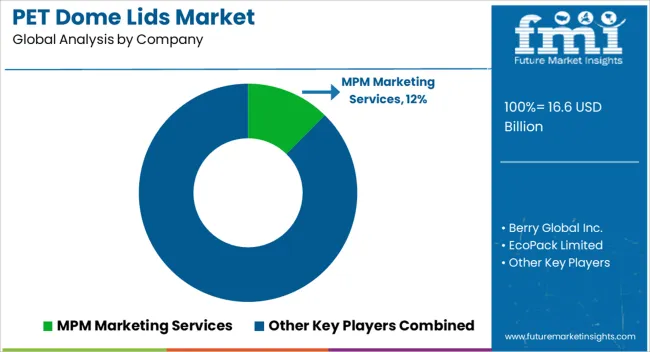
Key players in the PET dome lids market are strongly focusing on profit generation from their existing product portfolios along while exploring potential new applications.
The players are emphasizing on increasing their PET dome lids production capacities, to cater to the demand from numerous end use industries. Prominent players are also pushing for geographical expansion to decrease the dependency on imported PET dome lids.
Recent Developments:
| Attributes | Details |
|---|---|
| Forecast Period | 2025 to 2035 |
| Historical Data Available for | 2020 to 2025 |
| Expected Value in 2025 | USD 16.6 billion |
| Projected Value in 2035 | USD 33.2 billion |
| Growth Rate | 7.2% CAGR from 2025 to 2035 |
| Market Analysis | USD billion for value and Tons for Volume |
| Key Regions Covered | North America; Latin America; Western Europe; Eastern Europe; South Asia & Pacific; East Asia; Middle East & Africa |
| Key Countries Covered | United States, Canada, Brazil, Mexico, Germany, United Kingdom, France, Spain, Italy, Poland, Russia, Czech Republic, Romania, India, Bangladesh, Australia, New Zealand, China, Japan, South Korea, GCC Countries, South Africa, Israel |
| Key Segments Covered | Material, Design, End Use, Sales Channel, Region |
| Key Companies Profiled | MPM Marketing Services; Berry Global Inc.; EcoPack Limited; Sam's Club, Inc.; Georgia-Pacific LLC; Sabert Corporation; Dart Container Corporation; Amhil Europe; Aveco Packaging; YESECO |
| Customization & Pricing | Available upon Request |
The global PET dome lids market is estimated to be valued at USD 16.6 billion in 2025.
The market size for the PET dome lids market is projected to reach USD 33.2 billion by 2035.
The PET dome lids market is expected to grow at a 7.2% CAGR between 2025 and 2035.
The key product types in PET dome lids market are polyethylene terephthalate (pet), polystyrene (ps), polypropylene (PP) and others.
In terms of design, without cavity segment to command 59.3% share in the PET dome lids market in 2025.






Full Research Suite comprises of:
Market outlook & trends analysis
Interviews & case studies
Strategic recommendations
Vendor profiles & capabilities analysis
5-year forecasts
8 regions and 60+ country-level data splits
Market segment data splits
12 months of continuous data updates
DELIVERED AS:
PDF EXCEL ONLINE
Pet Perfume Market Size and Share Forecast Outlook 2025 to 2035
Pet Shampoo Market Size and Share Forecast Outlook 2025 to 2035
Pet Tick and Flea Prevention Market Forecast and Outlook 2025 to 2035
Pet Hotel Market Forecast and Outlook 2025 to 2035
PET Vascular Prosthesis Market Size and Share Forecast Outlook 2025 to 2035
Pet Food Preservative Market Forecast and Outlook 2025 to 2035
Petroleum Liquid Feedstock Market Size and Share Forecast Outlook 2025 to 2035
Pet Food Ingredients Market Size and Share Forecast Outlook 2025 to 2035
PET Stretch Blow Molding Machines Market Size and Share Forecast Outlook 2025 to 2035
PET Injectors Market Size and Share Forecast Outlook 2025 to 2035
PET Material Packaging Market Size and Share Forecast Outlook 2025 to 2035
Petri Dishes Market Size and Share Forecast Outlook 2025 to 2035
Petroleum And Fuel Dyes and Markers Market Size and Share Forecast Outlook 2025 to 2035
Petrochemical Pumps Market Size and Share Forecast Outlook 2025 to 2035
Pet Dietary Supplement Market Size and Share Forecast Outlook 2025 to 2035
PET Imaging Workflow Market Analysis - Size, Share, and Forecast Outlook 2025 to 2035
Petroleum Refinery Merchant Hydrogen Generation Market Size and Share Forecast Outlook 2025 to 2035
Pet Bird Health Market Size and Share Forecast Outlook 2025 to 2035
PET Film Coated Steel Coil Market Size and Share Forecast Outlook 2025 to 2035
Petroleum Refinery Hydrogen Market Size and Share Forecast Outlook 2025 to 2035

Thank you!
You will receive an email from our Business Development Manager. Please be sure to check your SPAM/JUNK folder too.
Chat With
MaRIA